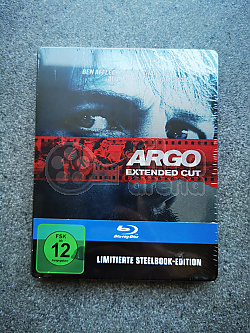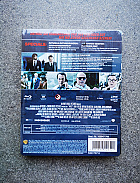Argo
The movie begins with a brief history of the Persian Empire, leading up to more modern times, when the Iranian leadership was overthrown in 1953, with the assistance of the United States and Great Britain. The pro-Western Shah of Iran led the country until 1979, when he was overthrown among great resentment among the people for his continuing efforts to westernize the country and for his repressive policies. Ayatollah Khomeini assumed control of the country. The Shah was exiled to Egypt and later went to the U.S. to receive cancer treatments. Although President Carter allowed the Shah to come to the U.S. for humanitarian reasons, the people of Iran viewed it as more fuel for the anti-American fire.
On November 4, 1979, militants are protesting outside the U.S. embassy in Tehran. They are demanding the Shah be returned to Iran to stand trial. When some of the protesters manage to scale the boundary fence, orders are given to start destroying all embassy records, some by shredding and some by burning. Equipment is also destroyed.
The head of embassy security attempts to go outside and reason with the militants, but he's immediately captured and taken hostage. The marines charged with guarding the embassy are armed, but their leader cautions them not to shoot anyone. They limit their efforts to the use of tear gas, but once the chains on the outside gates are removed, the militants storm the embassy and take 66 of the 72 diplomats and embassy staff hostage. Six of the staff, in the only building with a direct exit to the street, are able to escape and hide in the home of the Canadian ambassador Ken Taylor (Victor Garber). (Fourteen of the hostages were later released, mostly because they were from countries already considered repressed by the U.S., or for health reasons.)
One of the militants comes across a poster photo of the Ayatollah with several darts in it, adding to the furor of the moment.
In the following days, weeks and months, the hostages were blindfolded and paraded in front of TV cameras and jeering crowds. They were not allowed to speak or read, and they were rarely permitted to change clothes. Throughout the crisis there was a frightening uncertainty about their fate: The hostages never knew whether they were going to be tortured, murdered or set free.
Sixty-nine days into the crisis, the Canadians are increasingly uncomfortable with keeping the six Americans at their embassy. Word is that the Iranians have set up sweat shops utilizing Iranian children to go through the laborious process of piecing together the shredded documents. It's only a matter of time before they are able to realize that not all embassy staff have been accounted for and if they reconstruct photographs, they will know who to look for.
With the six escapees' situation thus far kept secret, the U.S. State Department begins to explore options for "exfiltrating" them from Iran. Tony Mendez (Ben Affleck), a CIA operations specialist, is brought in for consultation. Mendez criticizes the proposals submitted to that point, but he also doesn't have any better plan to offer. Then, one day he is at home watching the film "Battle for the Planet of the Apes" on TV with his son, and he's inspired to devise a plan to have the escapees pose as Canadian filmmakers, scouting "exotic" locations in Iran for a new sci-fi film. That would provide them a legitimate reason to leave the country.
Mendez and his supervisor Jack O'Donnell (Bryan Cranston) contact John Chambers (John Goodman), a Hollywood make-up artist who has previously crafted disguises for the CIA. Realizing they'll need as much legitimacy as possible to make the effort believable, Chambers contacts the film producer Lester Siegel (Alan Arkin). Initially skeptical, Siegel eventually agrees to help and together they set up a phony film studio, "Studio 6," publicize their plans, and establish the pretense of developing Argo, a "science fantasy" in the style of Star Wars, to lend credibility to the group's cover story.
The student militants threaten to try the 52 hostages as spies and carry out appropriate punishments. They go so far as to take a small group of hostages, tie them up, blindfold them, and line them up in preparation for execution by firing squad. The weapons are fired, but they are not loaded, so it turned out to be a cruel hoax. Martial law appears to be in effect throughout Iran, under the rule of the Ayatollah, with opposition members in some cases being shot or hung from the booms of construction cranes, after what amounts to trial via kangaroo courts.
Tensions rise as the Iranian housekeeper at the Canadian Embassy is starting to ask questions about the six "guests", such as why they never leave the residence.
As he offers the best of what seem to be nothing but bad proposals to effect a rescue of the six Americans, Mendez ultimately receives approval from the Secretary of State to proceed with his fictitious movie plan. He travels to Iran via Istanbul.
Posing as a producer for Argo, Mendez enters Iran and links up with the six escapees. He provides them with Canadian passports and fake identities to prepare them to get through security at the airport when it comes time to leave. Although afraid to trust Mendez's scheme, they reluctantly go along with it, knowing that Mendez is risking his own life too, and convinced that it is their only option. Each of the six is tasked with assuming a new identity, involving some use of physical disguise and memorizing details about their new personal histories.
The plan is for the group go out in public for a day to scout the local bazaar as a potential filming site. That is intended to add credence to their cover story, then they will leave the country the following day. The visit at the bazaar takes a bad turn when a local businessman takes exception at one of the women in the group taking photos. Fortunately, the group's Iranian culture contact is able to get them away from the increasingly hostile crowd, but the incident is very upsetting to everyone.
When it's learned that President Carter has authorized a Delta Force military rescue attempt of the 52 hostages, Mendez is told by O'Donnell that his smaller operation has been canceled, so as to avoid any potential conflicts. Mendez is furious. Because he feels personally responsible for the fate of the six, he decides to go ahead with the plan.
That night, Mendez and the six imbibe heavily in alcohol as they attempt to calm their nerves and prepare to either escape or die the next day.
The next morning, Mendez calls O'Donnell on a secure phone and tells him he's going ahead with the plan, then hangs up before O'Donnell can try to talk him out of it. O'Donnell is forced to scramble to get word of Mendez's decision to the secretaries of state and defense, and ultimately to President Carter, who is the only person who can re-authorize the purchase of tickets for Mendez and the six on a Swissair flight out of Tehran.
A member of the Ayatollah's regime goes to visit the housekeeper at the Canadian Embassy. Fortunately, her story provides continuing cover for the six U.S. embassy employees, as she lies and tells the official that the six had only been at the residence for two days. She must now find a way out of the country for her own safety (she goes to Iraq). The Canadian ambassador and his wife leave for the airport shortly after Mendez and the six do.
Tension rises at the airport for Mendez and the six. As they check in for their boarding passes, there is no record of any flight reservations. President Carter was just in the process of re-authorizing the mission. Mendez has no way of knowing this, but he asks the ticket agent to check again. This time, the reservations appear and they receive their boarding passes.
At the next security check for passports, a skeptical security official is reluctant to approve the six to continue on their way, as there is no original record of their having arrived in Iran two days before, just the carbon copies the six have with them. The official only changes his mind when a letter from the Iranian Minister of Cultural Works is handed to him. That letter provided authorization for the group to come to Iran.
As the group approaches the third tier of security at the airport, a member of the Iranian Revolutionary Guard is checking passports and boarding passes at the gate. He directs the six to a nearby room. The guard is also suspicious as to who they really are and what they are doing there. One of the six speaks Farsi and engages the guard in a dialogue about who they are and their reason for being in Iran. He produces copies of some of the movies' storyboards, and a copy of a newspaper advertisement for the movie. Mendez hands the guard a business card, for the fake production company back in Los Angeles, and tells him they can confirm the group's authenticity.
The guard examines the newspaper and places a call to the number on the card. However, Siegel and Chambers have been delayed from returning to their office by some ongoing filming taking place at the adjacent stage. Just as the guard is about to hang up the phone, Chambers answers. The guard asks to speak with Mendez. Chambers tells the caller that Mendez is out of country on a scouting trip. The guard hangs up and returns to the gate to authorize the group to proceed aboard.
Meanwhile, the children's sweat shop work had successfully re-constructed a photo of one of the six which was then matched to a surreptitious photo taken of the man at the bazaar the day before. Revolutionary Guards rush to the Canadian Embassy to find it abandoned and all the equipment destroyed.
The group boards the plane just before the Iranian guards at the airport are informed of the ruse. As the 747 taxis down the runway, it is chased by two Iranian police cars and a truck filled with Revolutionary Guards. The plane is going too fast for them to get in front of it. Mendez and the hostages breathe a sigh of relief only when the plane has left Iranian airspace. That was day 87 of the hostage crisis.
To protect the hostages remaining in Tehran from possible retaliation, all U.S. involvement in the rescue is suppressed, giving full credit to the Canadian government and its ambassador. Iranian government officials are very unhappy with the Canadians.
Back in the U.S., as Mendez is turning in his mission-related documents for storage at a CIA facility, he decides to keep one of the fictional movie story boards. He places it on a shelf in his son's bedroom, among other models and toys related to sci-fi movies.
Mendez is awarded the Intelligence Star, but due to the classified nature of the mission, he would not be able to keep the medal, or tell anyone that he'd received it. That changed in 1997, when President Clinton declassified the details of the event.
John Chambers was awarded CIA's Intelligence Medal of Merit for his involvement in the "Canadian Caper."
On Election Day, one year and two days after the hostage crisis began, Ronald Reagan defeated Jimmy Carter in a landslide.
On January 21, 1981, just a few hours after Ronald Reagan delivered his inaugural address, the remaining 52 hostages were released. They had been in captivity for 444 days.

















